Introduction
In 1504, following Duke Guidubaldo da Montefeltro’s (1472–1508) triumphant recapture of Urbino from Cesare Borgia (1475–1507), the city’s dying bishop, Giovanni Pietro Arrivabene (1439–1504), selected two foreign saints, Thomas Becket and Martin of Tours, as patrons for his burial chapel in the cathedral. The Montefeltro court artist Timoteo Viti (1469–1523) painted an altarpiece with their images (fig. 1) and designed the chapel’s now-lost fresco decoration, in which the main scene portrayed St. Martin exorcising a demon from a cow.Footnote 1 This article argues that the unusual iconographical choices for both the altarpiece and fresco represent a rare allegorical condemnation of Cesare Borgia’s campaigns to dominate Central Italy, and exculpate the bishop from the taint of collaboration with the Borgia regime. It further proposes a new identification for the young man accompanying the bishop in the Arrivabene altarpiece.

Figure 1. Timoteo Viti. Saints Thomas Becket and Martin of Tours with Two Donors (the Arrivabene altarpiece), 1504. Oil and gold on panel, 204 x 156 cm. Urbino, Galleria Nazionale delle Marche, 1990 DE 234. Mondadori Portfolio / Electa / Art Resource, NY ART433987.
The Mantuan prelate Giovanni Pietro (alias Giampietro) Arrivabene served as bishop of Urbino from 1491 until his death in 1504.Footnote 2 His last will and testament, written eight days before his death on 25 March, ordered the construction of a new chapel dedicated to Saint Martin, bishop of Tours, and Saint Thomas, archbishop of Canterbury, near the cathedral’s crossing.Footnote 3 The document provided an endowment of 300 gold ducats and a full complement of liturgical vestments, furnishings, missals, and a portable altar for the chapel. It also earmarked an additional 100 gold ducats for the chapel’s decoration, stipulating that an altarpiece depict both saints, and that a tomb slab be placed in the floor before the altar.Footnote 4 The will charges two powerful executors, Duchess of Urbino Elisabetta Gonzaga and the city’s podesta Alessandro Ruggieri, with carrying out the bishop’s wishes.
On 15 April 1504, the executors contracted to pay the painters Timoteo Viti and his assistant Girolamo Genga (ca. 1467–1551) sixty-five ducats — to be subtracted from the designated 100 ducats — for their work on the altarpiece and for the purchase of plaster, sand, and scaffolding to fresco the chapel.Footnote 5 An episcopal visitation in 1657 revealed that these frescoes, which depicted Saint Martin’s Miracles, once filled the chapel walls, the arch, and the vault or vaulted opening, but had been whitewashed at the time of Bishop Benedetto Ala (1610–20) because of their poor condition.Footnote 6 On 12 January 1789, the cathedral’s dome collapsed adjacent to the chapel, and the frescoes were lost during the reconstruction of the church in the neoclassical style by Giuseppe Valadier (1762–1839).Footnote 7 The altarpiece survived with minor damage, and is currently displayed in the Galleria Nazionale delle Marche.
In 1979 Sylvia Ferino Pagden identified a pen drawing in the Albertina, Vienna, as Timoteo Viti’s compositional study for a Miracle of Saint Martin frescoed in the Arrivabene chapel (fig. 2).Footnote 8 The drawing displays more than a dozen nude figures in various poses along with the saint, a demon, and a cow. These are set into a broad landscape that was likely intended to cover a wide surface area. Ferino Pagden also associated several individual figure studies with the scene, including detailed drawings of the collapsed bodies in the right background, which suggests that even these subsidiary figures were greatly enlarged for the fresco.Footnote 9 Given these reasons and the modest postwar budget for the decoration, the Albertina drawing most likely depicts the main or largest scene frescoed in the chapel.
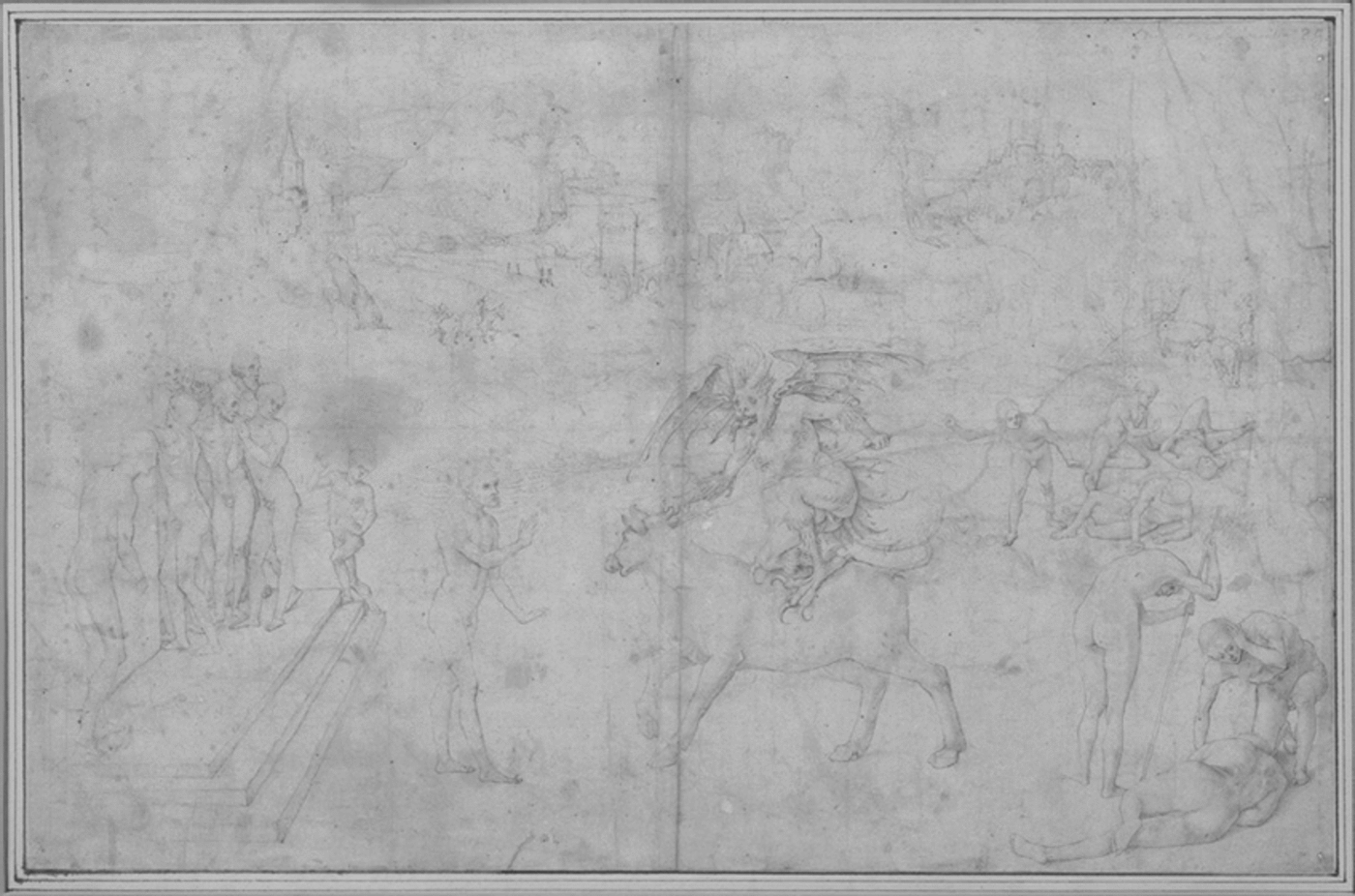
Figure 2. Timoteo Viti. Miracle of Saint Martin Exorcising a Demon from a Cow, 1504. Pen and ink on paper, 265 x 410 mm. Vienna, Albertina, 1458. © Albertina, Vienna www.albertina.at.
The April 1504 contract also mentions designs for the chapel, which may have included the Albertina drawing and a compositional study for the altarpiece in the British Museum, London (fig. 3). In addition, writers and art historians from Vasari forward agree that, despite Genga’s documented participation in the project, Viti alone painted the altarpiece, and they attribute all known preparatory drawings for the altarpiece and the main fresco to him.Footnote 10 Scholars also agree that the young Raphael, Timoteo Viti’s friend and subsequent collaborator, had nothing to do with the Arrivabene commission’s planning or execution.Footnote 11 At the time, Viti was the principal Montefeltro court painter, a position he obtained after the death of Raphael’s father, Giovanni Santi (1430/40–94).Footnote 12
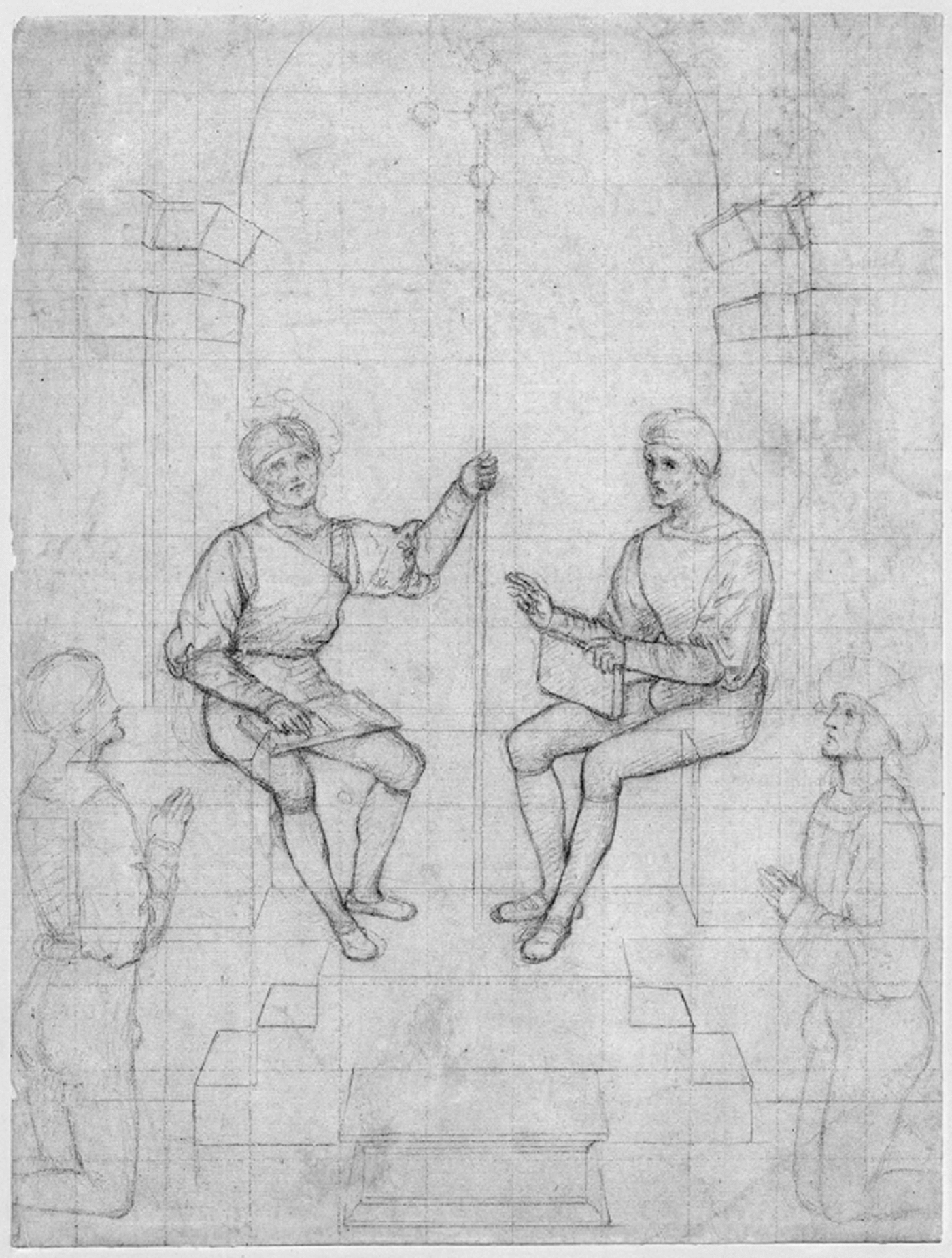
Figure 3. Timoteo Viti. Compositional Study for the Arrivabene Altarpiece, 1504. Black chalk on paper, 342 x 260 mm. London, British Museum, 1895-9-15-606. © The Trustees of the British Museum / Art Resource, NY ART477862.
In Arrivabene’s altarpiece, Viti depicted the bishop-saints Thomas and Martin seated side by side on a raised dais in front of a partially ruined, classicizing architectural backdrop that opens onto an extensive landscape. The figures’ elegantly restrained poses paired with the glowing palette of saturated colors and minutely detailed, verdant topography reveal Viti’s training in Francesco Francia’s studio and preference for the decorous maniera devota, or devout style.Footnote 13 The saints wear the gloves, rings, and miters characteristic of their offices, and are wrapped in gold damask copes lined with colored silk and edged with embroidered orphreys. Saint Thomas grasps the transparent shaft of an elaborate rock crystal and gold processional cross while pressing a liturgical book open on his lap, whereas Saint Martin rests a closed volume on its edge on his thigh. The pale, tonsured, gray-haired man in red kneeling on the lower left is a posthumous portrait of Bishop Arrivabene, while the younger figure at bottom right is often identified as the then-living Duke Guidubaldo da Montefeltro.Footnote 14
Prior studies have noted that Arrivabene, Saint Thomas, and Saint Martin all held episcopal office, and proposed that the bishop of Urbino modeled his life after these saints’ examples.Footnote 15 There has been, however, no further explanation for the bishop’s selections from the vast community of bishop saints, nor any indication that any chapel in the cathedral had ever been dedicated to Thomas or Martin. Indeed, their presence was so uncommon and their correct identification so important that Viti labeled them with gold letters, an infrequent practice for the artist. Closer examination reveals that Saint Thomas’s jeweled cope button represents Urbino’s patron Saint Crescentinus (ca. 276–303) lancing a dragon (fig. 4).Footnote 16 In addition, the saints’ orphreys bear tiny, indistinct images of saints identifiable by their attributes and context: Blaise, donning a miter and clutching the wool card of his martyrdom; Francis, dressed in a brown cassock holding a crucifix; the Blessed Mainardo, bishop of Urbino, with crook and miter, featuring a long white beard and brown robes; Stephen, in a red dalmatic with a stone on his head; Anthony of Padua, wearing a gray hooded mantle over a brown tunic and holding a lily; and Sebastian, nearly nude and bound to a tree. These marginalia confer local citizenship upon the two foreign saints by literally cloaking them in popular city and regional cult images.Footnote 17
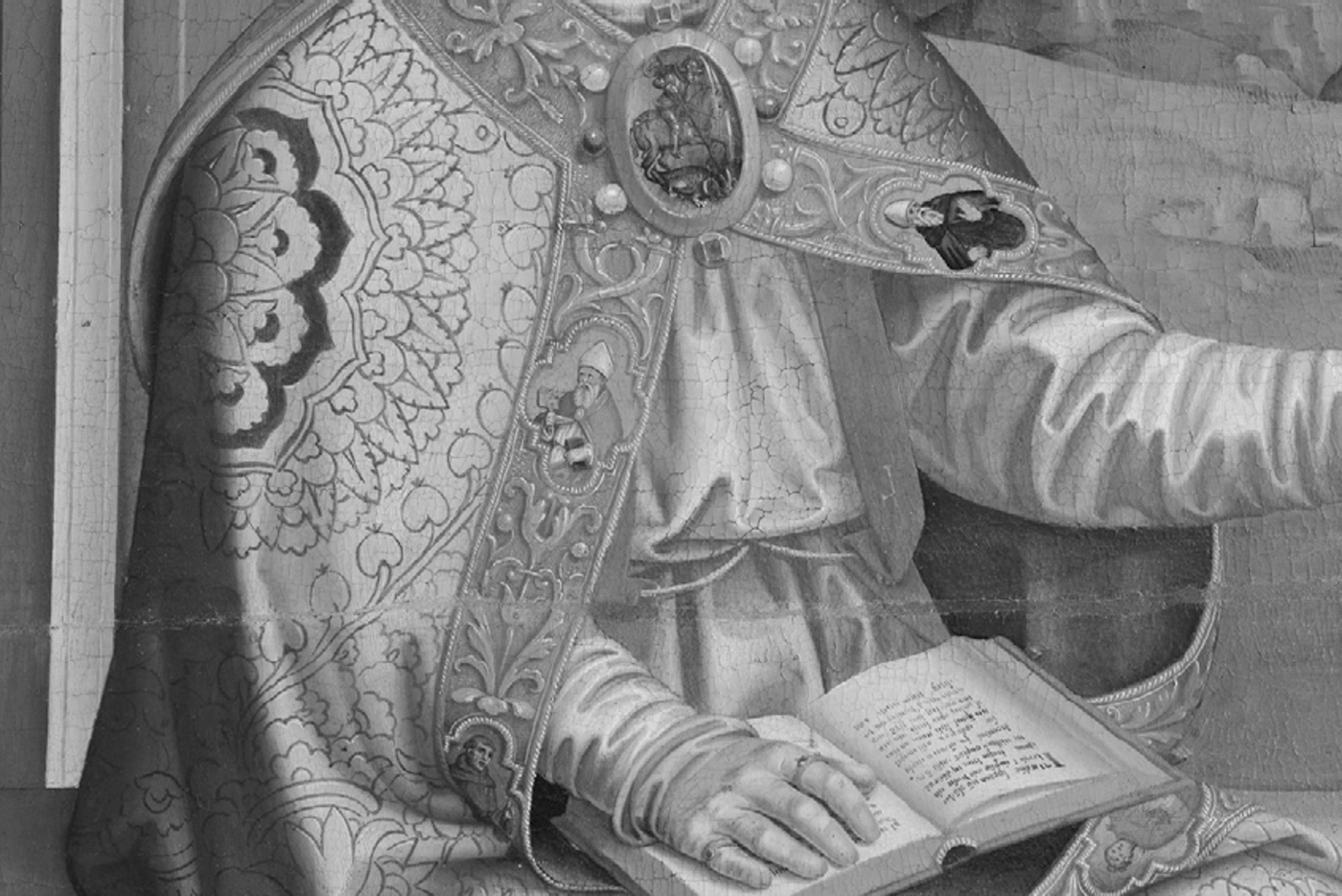
Figure 4. Timoteo Viti. Saint Thomas’s cope button with an image of Saint Crescentinus, and embroidered orphrey panels with images of Saints Blaise and Francis on the left, and the Blessed Mainardo and Saint Stephen on the right (detail of fig. 1). Courtesy of the Ministero dei Beni e delle Attività Culturali e del Turismo — Soprintendenza per i Beni Storici, Artistici ed Etnoantropologici delle Marche — Urbino, Archivio Fotografico.
Viti reinforced Saints Thomas’s and Martin’s equal status and significance in the altarpiece by seating them on the same level and providing them with comparable meaningful gestures. Saint Thomas looks toward the viewer, and Saint Martin bestows a two-fingered benediction on the departed patron. Several surviving preparatory drawings trace the nonlinear development of these figures. In Saint Martin’s case, both a black-chalk individual figure study of the artist’s hollow-eyed shop assistant (fig. 5) and the squared compositional drawing depict a studio stand-in gazing into space. A black-chalk drapery study with white heightening (fig. 6) and the final painted altarpiece show that Viti first tentatively experimented with Saint Martin’s gestures, then ultimately adjusted the saint’s head and hand to bless Bishop Arrivabene. Each drawing displays Timoteo’s distinctive style through a combination of reinforced contours and nearly horizontal, rigidly parallel hatching lines.

Figure 5. Timoteo Viti. Figure Study for Saint Martin in the Arrivabene Altarpiece (a.k.a. Study of a Seated Youth), 1504. Black-and-white chalk on pale brown paper, 262 x 178 mm. London, British Museum, 1953-12-12-2. © The Trustees of the British Museum / Art Resource, NY ART477829.

Figure 6. Timoteo Viti. Drapery Study for Saint Martin in the Arrivabene Altarpiece, 1504. Black-and-white chalk with wash on white paper, 237 x 164 mm. Pesaro, Biblioteca Oliveriana, 137. © Biblioteca Oliveriana, Pesaro.
Viti’s labor-intensive process, which likely included the production of additional full-scale paper cartoons (now lost), was part and parcel of Central Italian practice of the period.Footnote 18 Viti’s studies of lanky, wiry nudes for the miracle fresco also reveal his admiration for Luca Signorelli’s figural style, which had reached the height of its popularity in the years following the unveiling of the spectacular San Brizio chapel in the cathedral of Orvieto (1502).Footnote 19 The novelty of the Arrivabene altarpiece and miracle fresco lies not in the individuality of the artist’s style or technique, but rather in how the ensemble of figures and actions express the patron’s wishes through the chapel’s allegorical conceits. Yet the altarpiece’s intelligent employment of gesture, sacred legend, and heraldic symbol only becomes apparent after a detailed examination of the complex circumstances surrounding the patron’s demise and the chapel’s execution.
The Ecclesiastical Career of Giovanni Pietro Arrivabene
Arrivabene hailed from a dynasty of Mantuan notaries.Footnote 20 He studied Greek and Latin in Milan and Pavia with Francesco Filelfo, who nicknamed him Eutychios — Greek for “lucky” and a pun on the auspicious Italian surname Arrivabene, or “fortunate.”Footnote 21 As a newly minted Renaissance humanist scholar, Arrivabene tried his hand at encomiastic Latin poetry, although in the long term he showed his true gifts were for letter-writing and administration.Footnote 22 He began his secretarial career in the 1460s by serving Cardinal Francesco Gonzaga (1444–83) in Mantua, Bologna, and Rome, while writing gossipy reports to the cardinal’s mother, Barbara of Brandenburg. When Cardinal Gonzaga died in 1483, Arrivabene moved to the papal curia where he climbed through the offices of apostolic secretary and chancery abbreviator to protonotary in 1488. His name and notarial sign appear on several papal bulls and briefs and he often acted as de facto Mantuan ambassador to the Holy See.Footnote 23
In a biographical study of the bishop, David Chambers describes Arrivabene as a Vatican insider with an office in the Apostolic Palace and direct access to the pope.Footnote 24 Arrivabene served as secretary to three popes: Sixtus IV della Rovere, Innocent VIII Cybo, and Alexander VI Borgia. He also acted as Sixtus IV’s ambassador to King Ferdinand I (alias Ferrante) of Naples in 1484. Although Arrivabene was a possible candidate for cardinal, in 1491 Innocent VIII appointed him bishop of Urbino instead.Footnote 25 The new bishop remained with the curia in Rome for more than a year before taking up residence in his diocese. In 1498, Pope Alexander VI specifically recalled Bishop Arrivabene from Urbino to Rome to act as his personal secretary for yet another year.Footnote 26 Arrivabene was proud of his titles, often signed documents as both bishop and protonotary, and instructed in his will that his epitaph list the popes he had dutifully served as well as his chancery, diplomatic, and pastoral offices.Footnote 27 In the altarpiece, however, there is no sign of his wide-brimmed black protonotary’s hat or bishop’s miter. Timoteo Viti painted him wearing an episcopal red cloak, but kneeling bareheaded before Saints Thomas and Martin, with only a soft, black skullcap resting humbly on the pedestal at the saints’ feet.Footnote 28
Chambers’s analysis of Arrivabene’s letters reveals a complex, contradictory character. The secretary-bishop’s friends described him as modest, serious, prudent, and learned — though by middle age, he also harbored a “self-righteous sense of persecution” coupled with a perceived need to defend himself from calumny.Footnote 29 For example, in 1483 he wrote the Marquis of Mantua to vigorously protest against accusations of dishonesty when he was the executor for Cardinal Gonzaga’s estate. In 1488, Arrivabene claimed that his close relationship with Pope Innocent VIII sparked jealous slander, and he urged friends to write letters in his defense.Footnote 30 Arrivabene was fortunate, indeed, to receive the bishop’s miter of Urbino, which was closely allied to his native Mantua through Duke Guidubaldo’s marriage to Elisabetta Gonzaga. He exercised his authority as bishop conscientiously and energetically. He reorganized the cathedral’s account books, enforced careful recordkeeping, hired masters to teach grammar and singing, composed an office for Saint Crescentinus, conducted visitations, and proposed improvements to diocesan churches — in short, he endeavored to make his mark as a dedicated reformer.Footnote 31 But Arrivabene’s loyalties to city, office, and the Church itself would be sorely tested when Pope Alexander’s son, Cesare Borgia, captured Urbino twice in an effort to establish a monarchy within the Papal States.
The Military Campaigns of Cesare Borgia
A review of Central Italian geography, as well as relevant military and political history, helps to contextualize the bishop’s difficult situation during Cesare Borgia’s three major campaigns to subjugate Central Italy in 1499–1502, preceding the Arrivabene chapel commission. Because it controls the mountainous area near a vulnerable bend joining the Renaissance iterations of the ancient Roman Via Aemilia and Via Flaminia (the main arteries connecting Emilia, Romagna, the Marches, and Umbria to the Eternal City), the capital city and entire Duchy of Urbino occupied a strategic location in the Papal States. Local lords, with nominal fealty to Rome as vicars of the pope, ruled the principal city-states in the regions along the Aemilia-Flaminia route; they included the Bentivoglio in Bologna, the Manfredi in Faenza, the Malatesta in Rimini, the Montefeltro in Urbino, and the Varano farther afield in Camerino.Footnote 32 The young, ambitious Cesare Borgia, with both foreign and papal backing, plotted to seize all of this territory to form a new, hereditary duchy. On his return from France in November 1499, armed with the title of Duke of Valentinois (aka Duca Valentino) and hundreds of French lances provided by King Louis XII, Cesare marched along the Via Aemilia and vanquished the Romagna, taking the cities of Cesena, Forlì, and Imola. He then bypassed Urbino and returned along the Via Flaminia to Rome, where he held his first triumph on 25 February 1500.Footnote 33 On 29 March, Alexander VI invested Cesare with the two highest titles in the papal army, captain general and gonfaloniere (standard-bearer) of the Church.Footnote 34
Later that year, on a second campaign to consolidate his conquests, Cesare departed from Rome on 2 October with the papal blessing, financing, and armies, and marched north on the Via Flaminia past Urbino and then along the Via Aemilia into the upper Romagna, threatening Bologna. The following spring he returned with his army toward Rome by taking the direct route to Florence and making for the ancient Via Cassia, striking fear throughout Tuscany. The Florentines protested vigorously to the pope and begged protection from the king of France. Their successful entreaties closed the Cassia to Cesare’s army, forcing his troops to continue by boat from Piombino.Footnote 35 Without the Cassian itinerary as an option, Cesare realized that he would need to secure the Via Flaminia and repeatedly traverse Montefeltro territory, near its capital of Urbino, in order to manage his conquered territories in the Romagna from Rome.
At first, this did not impede Cesare’s ambitious plans. As vicar of the Papal States, the chivalrous Duke Guidubaldo da Montefeltro was the pope’s vassal. He remained loyal to Alexander VI and subordinate to the captain and standard-bearer of the papal armies throughout Cesare’s campaigns to conquer the cities flanking the Duchy of Urbino, despite his previous humiliating capture and ransom while in Borgia service against the Orsini at Soriano in 1497.Footnote 36 As a display of his goodwill and allegiance toward the papal family, in January 1502 Guidubaldo spent more than 8,000 ducats feting Lucrezia Borgia while she was en route to marry Ferrante d’Este in Ferrara.Footnote 37
Meanwhile, in early 1502, Cesare, newly fashioned Duke of the Romagna, expanded into the Marches, laying siege to Camerino. The city refused to fall easily and, in June, Cesare asked Guidubaldo for safe passage of the papal artillery through Montefeltro territory to support the siege. Guidubaldo granted permission, maintaining his loyalty to the Church and its Borgia captain and standard-bearer. He couldn’t foresee that on 20 June 1502, Cesare would race from Camerino to join the artillery at Cagli near the city of Urbino, and simultaneously order his forces in Fano and troops from the Romagna to converge on the Duchy of Urbino. Cesare’s betrayal shocked Guidubaldo. Unprepared and surrounded, he escaped on horseback disguised as a peasant and rode through the summer night pursued by Borgia soldiers.Footnote 38 Cesare held Urbino for some months, until several of his captains conspired against him at the Diet of La Magione (held near Perugia) and aided Guidubaldo in retaking Urbino that October. But by December 1502 Cesare convinced the captains to rejoin him and regained control of the city. He then famously deceived, captured, and garroted his former traitors at Senigallia on 1 January 1503.Footnote 39 For the citizens of the Duchy of Urbino, this period was marked by the loss of lives, property, and livestock. For art historians today, the year 1502 is best remembered for Cesare Borgia’s notorious sack of Urbino’s ducal palace. He carted away to his fortress at Forlì the art, furnishings, and famous library established by Guidubaldo’s father, Duke Federigo da Montefeltro. The booty was valued at an estimated 150,000 ducats and the transport of goods reportedly employed 180 pack mules per day for an entire month.Footnote 40
These events had unfortunate consequences for Bishop Arrivabene. Immediately upon taking Urbino in June 1502, Cesare Borgia used the bishop’s palace as an instrument of his new regime. He ordered Arrivabene to host the Florentine ambassadors Francesco Soderini and Niccolò Machiavelli.Footnote 41 This was not unusual, as Cesare often commandeered Church property and persons to govern his Central Italian state.Footnote 42 The diplomatic role presented Arrivabene with a quandary. On the one hand, he had known Rodrigo Borgia (Pope Alexander VI) for thirty years, respected him, had benefited from his favor, and had recently acted as his papal secretary. He had also spied for the Borgia pope in 1499.Footnote 43 On the other hand, Arrivabene had served the Gonzaga even longer, and shared Mantuan citizenship with the deposed Gonzaga Duchess of Urbino. He was also bishop of Urbino and feared for the safety of his flock. While irreconcilable differences between secular and religious loyalties often characterized Italian Renaissance politics, contrasting allegiances still troubled individual players — particularly those who chose sides.
Previous scholars have been unable to agree whether Bishop Arrivabene resisted Cesare Borgia or, like the legendary English vicar of Bray, nimbly shifted allegiances in order to maintain his office and ingratiate himself with the new ruler.Footnote 44 Circumstantial evidence, however, suggests that Arrivabene opposed Cesare’s rule. The bishop was among the first to welcome Guidubaldo upon his brief recapture of Urbino in October 1502.Footnote 45 Moreover, Arrivabene visited La Magione on 9 November, when it served as headquarters for the anti-Borgia conspiracy.Footnote 46 Diplomatic letters confirm that, just before Urbino surrendered to Cesare for the second time, Arrivabene had publicly and privately requested refuge in Florentine territory. Piero Soderini, gonfaloniere for life of the Florentine Republic, rebuffed the bishop’s entreaties to avoid provoking Cesare.Footnote 47 Arrivabene was conspicuously absent on 9 December 1502, when Monsignore Guido Staccoli officiated the Mass of the Holy Spirit in honor of the Borgia reconquest of Urbino, after which the citizens swore their allegiance to Cesare.Footnote 48 It is likely that Arrivabene had fled to his hometown of Mantua or another location outside Borgia control.
The Borgia Bull
Borgia rule was firmly established, and the bishop was elsewhere, when the former Montefeltro court artist Timoteo Viti was paid to paint Cesare’s coat of arms on Urbino’s palace of the priors and city gates on 31 January 1503.Footnote 49 These murals do not survive, but various other illuminated, painted, and sculpted examples of Borgia coats of arms do. The Borgia arms display a red bull or ox (which are often interchangeable in Renaissance heraldry) grazing on a green field over a gold background surrounded by a border with tufts of grass.Footnote 50 This emblem made its debut in Rome during the reign of Pope Alexander VI’s maternal uncle, Pope Calixtus III Borgia (1378–1458). The bull features prominently on the left side of Alexander’s coat of arms, while the right half shows the gold and black horizontal bars derived from his great grandfather’s marriage to the Doms family, though Alexander favored his connection to Calixtus (fig. 7).Footnote 51 After he obtained French titles in 1499, Cesare Borgia further quartered Alexander’s bipartite arms with fleurs-de-lis on blue fields. Then, upon taking command of the papal armies in 1500, he added a central vertical band with the papal pavilion and crossed keys.Footnote 52 The bull remained a preferred family device and is conspicuously displayed in the upper right corner of Cesare’s arms, as exhibited in a rare, extant, yet eroded marble relief immured into the fortress at Forlì (fig. 8).
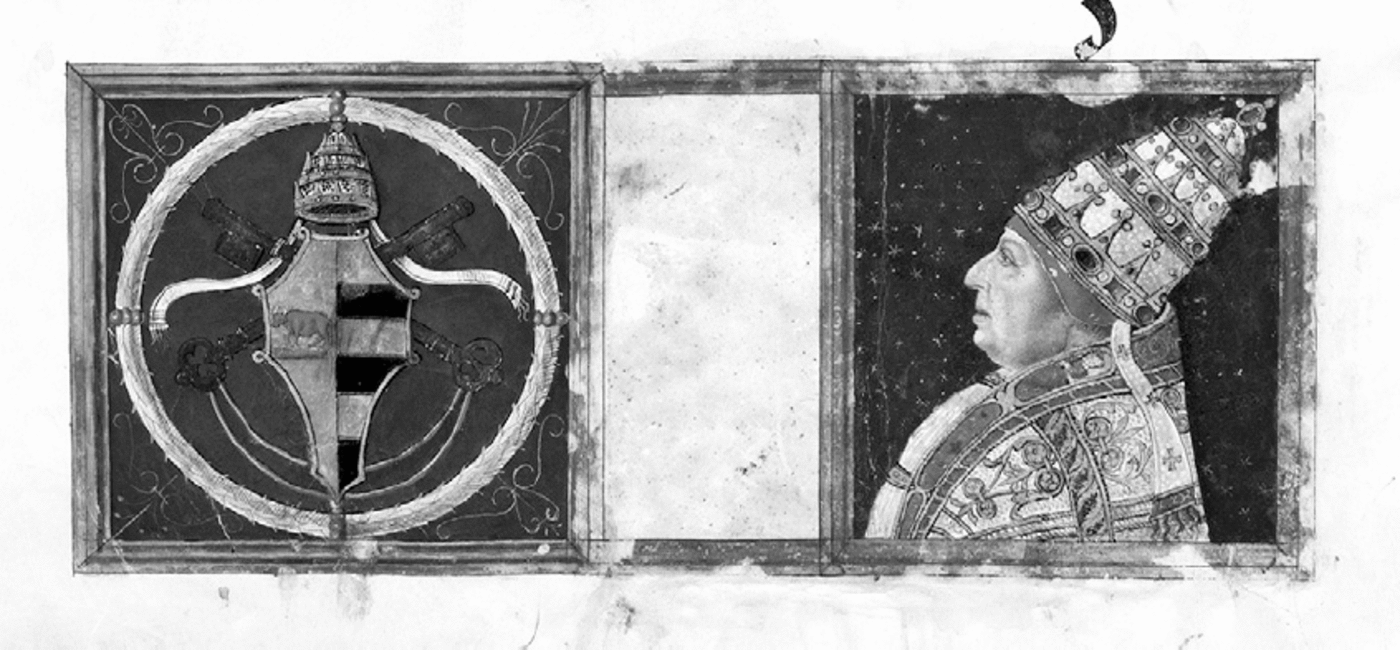
Figure 7. Unidentified Umbrian illuminator. Coat of Arms and Portrait of Pope Alexander VI, ca. 1492–95, from the Christmas Missal of Pope Alexander VI. Vatican City, Vatican Library, Borg. lat. 425, fol. 8v. Courtesy of the Biblioteca Apostolica Vaticana, all rights reserved.
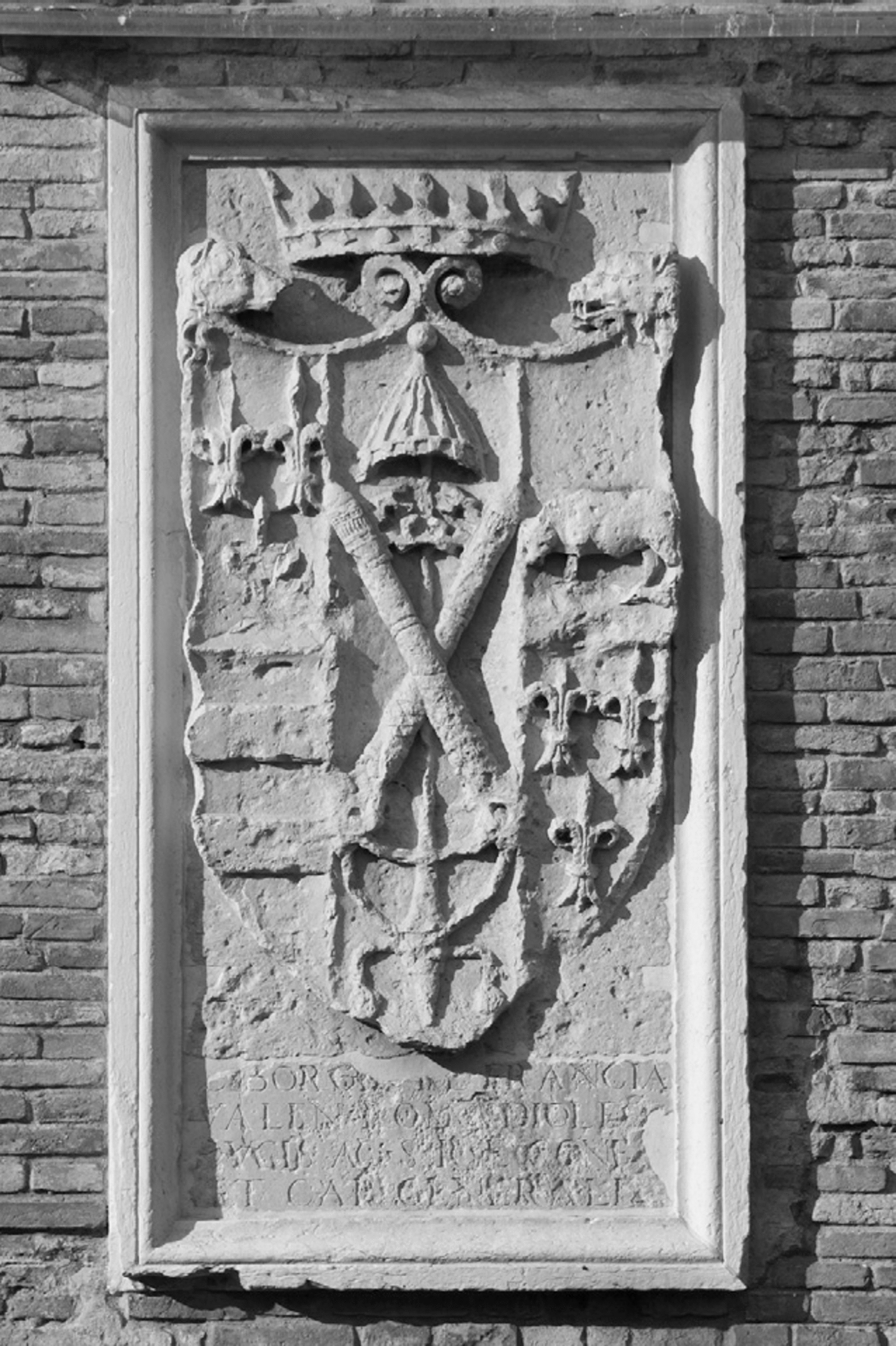
Figure 8. Unknown sculptor. Cesare Borgia’s Coat of Arms, ca. 1500. Marble. Forlì, Rocca di Ravaldino (author’s photo).
The bull became synonymous with the Borgia family, and its image appears frequently throughout Borgia material culture. In Alexander’s Vatican apartments, the Egyptian sacred bull Apis replaced the placid grazing cattle in the old family arms, while oxen, cows, and bulls proliferate in a complex decorative scheme that blends pagan and Christian symbols (fig. 9).Footnote 53 A bull featured on the huge papal standard mounted atop Castel Sant’Angelo, adorned the papal arms in numerous churches, and even glinted from the blade of Cesare Borgia’s ceremonial sword.Footnote 54 To further bind the image of the bull to the Borgia and the family’s homeland of Spain (Valencia), Cesare practiced the art of bullfighting in Rome.Footnote 55
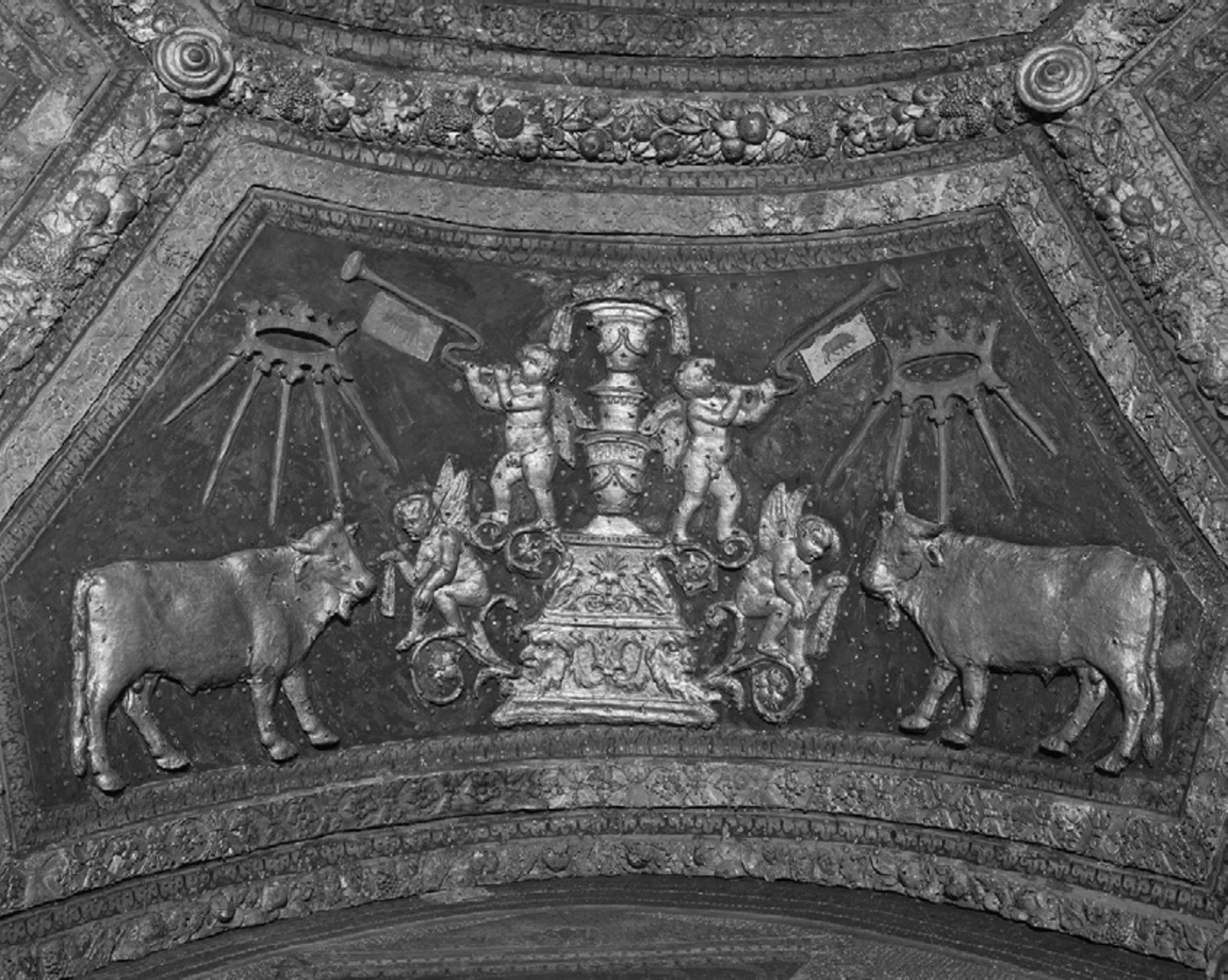
Figure 9. Bernardo Pinturicchio and workshop. Borgia emblems, ca. 1492–94, Borgia Apartments, Vatican Palace, Vatican City. Scala / Art Resource ART368283.
After the family’s eventual defeat, the Borgia arms were effaced in Urbino and other conquered cities. But the memory of the Borgia bull’s rampage through the cities of the Romagna and the Marches remained fresh in Timoteo Viti’s mind during the spring of 1504, when he sketched Saint Martin exorcising the devil from a cow and likely showed it to Bishop Arrivabene’s executors. This miracle of Saint Martin appears so seldom in Italian art that scholars have found only one other Renaissance example: a predella compartment painted two decades later in Luca Signorelli’s workshop.Footnote 56 According to the story in Jacobus da Voragine’s widely known Golden Legend, a cow possessed by the devil “roared and raged and gored many people.” When the cow turned to attack Saint Martin, he ordered her to halt and identified a demon riding her (visible only to the saint). He then commanded: “Get off her back, O evil one, and stop tormenting this harmless animal.”Footnote 57 The demon fled and the cow returned meekly to the herd.
In his compositional drawing in the Albertina (fig. 2) and in the lost fresco for the Arrivabene chapel, Viti represented Martin’s horned cow without obvious signs of gender, such as teats. Rather, it takes the iconic pose of an animal emblem that resembles the Borgia grazing bull passant, which the artist transformed into a charging bull trampling the green fields, harming and frightening several men. In the context of Urbino in 1504, viewers would likely have recognized the pointed reference to Borgia heraldry, and interpreted this scene of demonic bovine possession as an allegory of Borgia expansionism and the devastation of the Duchy of Urbino. Arrivabene had served the once-peaceful beast, and the old adage that the devil made him do it provided a convenient excuse for Cesare Borgia’s bellicose behavior.Footnote 58
Arrivabene had additional reasons to identify with Saint Martin and for Viti to paint the saint in the act of blessing the bishop in the altarpiece. Although born in Pannonia and appointed to a French see, Martin grew up in Pavia and performed many miracles in Milan, two cities where Arrivabene had studied in his youth. Also, as Jacobus da Voragine explains in the Golden Legend, Martin overcame opposition to his election as bishop of Tours, an example that probably heartened Arrivabene as he endured challenges while reforming his own diocese of Urbino. As a former Roman soldier, Martin traded temporal arms for spiritual ones, and refused to fight when provoked and when barbarians overran the empire’s borders.Footnote 59 Arrivabene may have justified his early lack of opposition to Cesare Borgia’s army in similar terms.
Perhaps the bishop truly believed that Saint Martin had answered his prayers and pacified the Borgia bull in August 1503. Pope Alexander and Cesare summered at the Vatican that year, despite the notoriously unhealthy air. Both became ill; Alexander died on 18 August and Cesare was weakened by fever and medical treatments.Footnote 60 The repercussions were rapid: Guidubaldo recaptured Urbino on 28 August,Footnote 61 and Cesare lost cities in the Romagna while recuperating at the Borgia stronghold in Nepi. Weeks later, Cesare returned to lead the papal armies, but his Duchy of Romagna buckled. His enemies closed in during the twenty-six-day reign of Pope Pius III Piccolomini. Pius’s successor, the newly elected Pope Julius II della Rovere, imprisoned Cesare at Ostia in November, effectively ending Borgia tyranny (except for control of the castle in Forlì). Before the close of 1503, Guidubaldo had reclaimed the entire Duchy of Urbino. In September of 1504, Julius II appointed Duke Guidubaldo da Montefeltro — who was his relation — captain general of the papal armies.Footnote 62
Two other events marked the restoration of the Montefeltro in Urbino and Bishop Arrivabene’s absolution. On 2 December 1503, Julius II held an audience with Guidubaldo and Cesare in order to negotiate the return of Urbino’s looted treasures and library. According to an anonymous chronicler, Cesare threw himself at Guidubaldo’s feet, begged for mercy, and blamed Pope Alexander.Footnote 63 That same day, Duchess Elisabetta Gonzaga returned to Urbino from exile with her family in Mantua. The Mantuan ambassador reported that during the celebration of a thanksgiving Mass in the cathedral, “Bishop Arrivabene came before everyone, adorned ecclesiastically. He took Our Lady Duchess by the hand and went to kneel before the high altar, where all the clergy was, and they began to sing Te Deum Laudamus,” the joyous hymn of praise to God.Footnote 64 In one brilliant stroke, Arrivabene employed the liturgy to publicly display his affiliation and disassociate himself from past ties to the Borgia. In private, he undoubtedly reminded the duchess of their shared Mantuan heritage, his long service to the Gonzaga, and his loyalty to the Duchy of Urbino. He cemented this bond a few months later by appointing Elisabetta an executor of his will.
By specifying the subjects for his funeral chapel in his testament, Arrivabene ensured that the chapel and altarpiece would be encoded with visual messages overtly explaining himself to posterity from a conspicuous position in the cathedral. He clearly desired association with Saint Martin, and Viti fulfilled this wish by painting Martin blessing the bishop’s effigy and pacifying a cow resembling the Borgia bull. Arrivabene also chose to include an image of Saint Thomas Becket of Canterbury as his saintly guide and example. Despite a strong international cult in the Middle Ages, the English Saint Thomas seldom appears in Italian Renaissance painting.Footnote 65 It is tempting to propose that Guidubaldo’s election to the English Order of the Garter in February 1504 resulted in a wave of anglophilia in Urbino that influenced the bishop’s choice of Thomas.Footnote 66 While this may be a contributing factor, the saint’s image in the Arrivabene altarpiece, and the lessons embedded in Thomas’s legend, more likely addressed any lingering doubts concerning the bishop’s loyalty to God’s Church rather than Cesare’s monarchy.
Thomas Becket was a close companion of the young King Henry II and served as his chancellor until the king nominated him for archbishop of Canterbury. The new role changed Thomas, who began to wear a hair shirt and perform acts of humility. According to the Golden Legend, he resisted when “the king made every effort to bend Thomas to his will at the expense of the Church. [The king] wanted the archbishop to confirm certain customs that were contrary to the Church’s liberties, as his predecessors had done. Thomas absolutely refused, thus drawing upon himself the wrath of the king and his barons.”Footnote 67 Misled by counselors, Thomas gave oral consent to the royal demands; but he imposed severe penances upon himself. When the king ordered written consent, and clerics began to conspire against Thomas, the archbishop held the cross of his office high and quit his post to shouts of “hang the traitor!” Thomas went into exile in France, where he was welcomed at Sens by Pope Alexander III. He eventually returned to England, but still refused to comply with the king’s orders and maintained the rights of the Church. The Golden Legend recounts that on 29 December 1170, the king’s knights burst into Canterbury Cathedral searching for Thomas, who bravely replied, “Here I am! . . . I am ready to die for God, to defend justice, and to protect the freedom of the Church.”Footnote 68 They split his skull. In the aftermath of this martyrdom, King Henry accepted blame, reconciled with the Church, and submitted to a humiliating penance.Footnote 69
Since his canonization in 1173, Saint Thomas of Canterbury has, in Anne J. Duggan’s words, “encapsulated all the claims of the Church to independence and freedom, and his dispute with Henry II became an inspiration to later primates in their disputes with their own kings.”Footnote 70 During the occupation of Urbino in 1502–03, the story of the saint’s life and martyrdom would have appealed to Bishop Arrivabene, who faced political persecution and was consumed by righteous (or perhaps self-righteous) indignation over Duke Cesare Borgia’s abuses of the Church. Indeed, Arrivabene had plenty of reasons to imagine that his own circumstances vis-à-vis the Borgia mirrored those of Saint Thomas’s life, and to mandate the saint’s eternal presence in his painting.Footnote 71 The parallels between them are notable: Thomas was Henry’s chief administrator, as Arrivabene had served as secretary and protonotary to Rodrigo Borgia. Thomas had at first agreed to Henry’s demands on the Church, just as Arrivabene had at least tacitly assented to Cesare Borgia’s use of the bishop’s palace of Urbino, and watched as the new duke of the Romagna employed the Church’s funds and ministers in the administration of a secular duchy carved from the Papal States. As Thomas had refused Henry, Arrivabene defied Cesare by attending the Diet of La Magione. When Urbino returned to Borgia control Arrivabene fled his diocese, as Thomas had left England and, ironically, joined Pope Alexander VI’s earlier namesake abroad. It is entirely conceivable that Arrivabene believed, or wanted others to believe, that he had been ready to return from exile and face execution as a traitor by Borgia soldiers in the cathedral of Urbino, as Saint Thomas had been martyred by King Henry’s knights at Canterbury. Arrivabene may well have considered Cesare Borgia’s capitulation to Pope Julius II and reconciliation with Duke Guidubaldo on 2 December 1503 as a modern analog to King Henry II’s submission to Pope Alexander III in 1172.
As outlined in Arrivabene’s will, Timoteo Viti portrayed the bishop in the altarpiece kneeling before two saints with whom the patron closely identified: Saint Thomas, the defier of a king who had abused the Church as Cesare Borgia had done, and Saint Martin, the metaphorical tamer of Borgia bulls. Taken in the context of Urbino in the spring of 1504, this altarpiece and the chapel’s lost fresco display the bishop’s dual concern for his salvation and posthumous reputation. But the decoration of the Arrivabene chapel has greater significance for the history of art beyond one man’s message to the future. Both the altarpiece and the preparatory drawing of the miracle of Saint Martin exorcising the devil from a cow are extraordinary allegorical responses to the devastating Borgia campaigns to dominate Central Italy.Footnote 72
An inscription in the open book on Saint Thomas’s lap in the altarpiece corroborates this new interpretation of the highly personal nature of Arrivabene’s commission (fig. 10). Written in inverted, abbreviated chancery script, it is a clever game inserted into a monument for a sharp-eyed papal secretary accustomed to deciphering manuscripts. The text begins with the abbreviated Latin phrase “In te domine sperava non confundar,” which is the first line from Psalm 31, “In you Lord have I hoped, let me never be confounded.”Footnote 73 The painted inscription fades into hash marks, but the ecstatic Psalm of persecution and righteousness continues: “For I have heard the blame of many that dwell round about. While they assembled together against me, they consulted to take away my life. But I have put my trust in you, O Lord: I said: you are my God. My lots are in your hands. Deliver me out of the hands of my enemies; and from them that persecute me.” These words echo Bishop Arrivabene’s self-righteous nature and paranoia during Cesare Borgia’s occupation of Urbino and his self-exile. The Borgia had tested Arrivabene’s loyalties to church and state, but the bishop refused to be confounded.
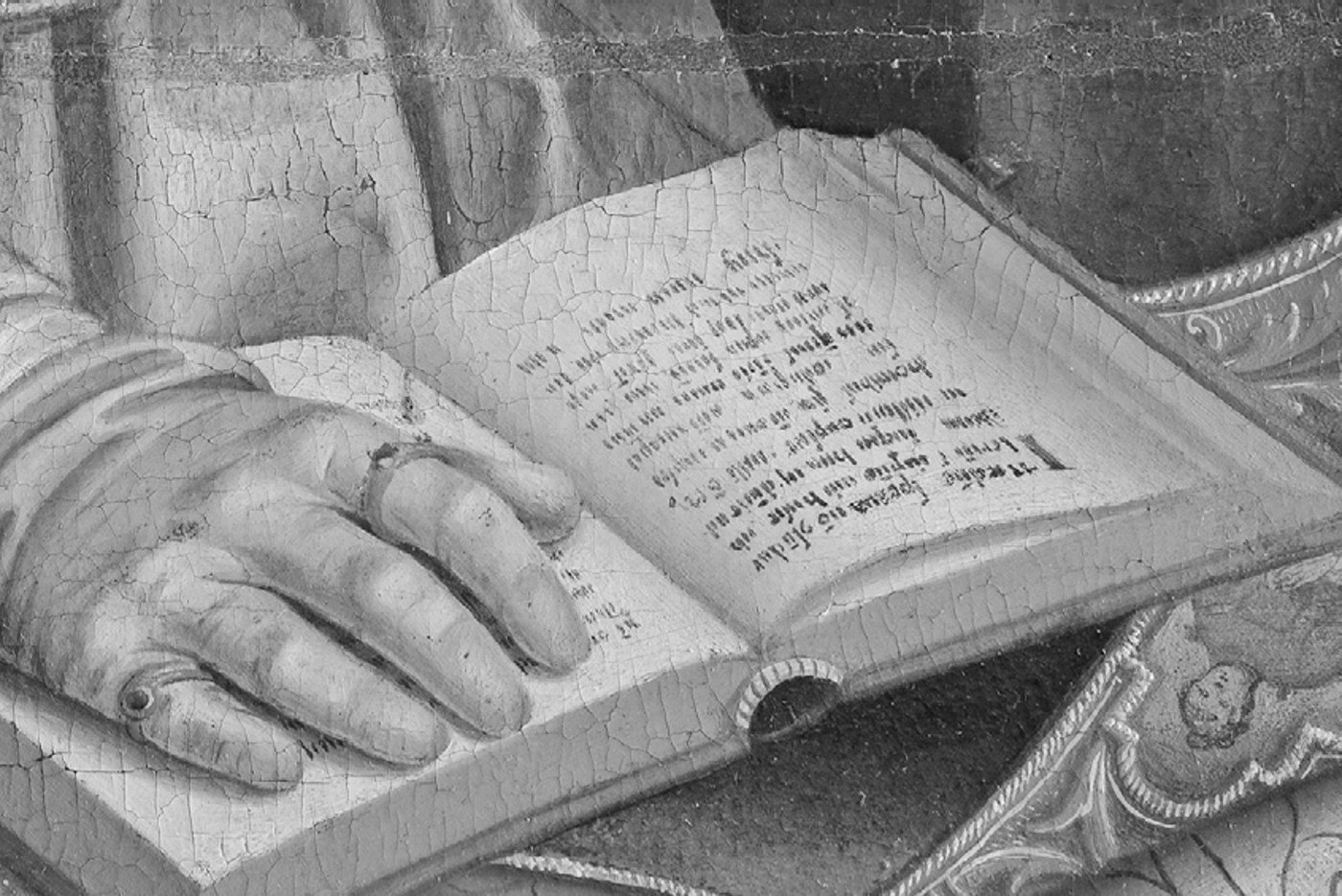
Figure 10. Timoteo Viti. Book in Saint Thomas’s lap (inverted), Arrivabene altarpiece (detail of fig. 1). Courtesy of the Ministero dei Beni e delle Attività Culturali e del Turismo — Soprintendenza per i Beni Storici, Artistici ed Etnoantropologici delle Marche — Urbino, Archivio Fotografico.
A New Identity for the Second Donor Portrait in the Arrivabene Altarpiece
A reconsideration of the Arrivabene chapel as a display of the bishop’s personal history and interests leads to a further consideration about the identity of the man kneeling in the lower right corner of the altarpiece (fig. 11). Viti depicted his face with a naturalism that rivals the precision of Perugino’s contemporary Flemish-inspired portraiture, and it stands in stark contrast to the bishop’s less detailed, posthumous effigy.Footnote 74 Several scholars have claimed that the young man’s carefully delineated profile portrays Duke Guidubaldo da Montefeltro, although three observations challenge this assertion. First, the figure occupies the heraldically junior position of the composition on the saints’ proper left (sinister) side, while Arrivabene commands Thomas’s and Martin’s privileged dexter flank. This location would have suggested that Arrivabene inappropriately placed himself above the duke within a widely understood visual-hierarchical system. Second, the figure bears no obvious sign of ducal rank. Aside from fur cuffs and heavy cloak, he lacks a hat or chain of office, an oddity given that Arrivabene, appropriately bareheaded in the company of the divine, is nevertheless represented wearing an episcopal red robe and near his ecclesiastical black zucchetto. Third, the kneeling figure has dark-brown hair with heavy bangs and an inward lower curl, whereas literary and visual portraits of Guidubaldo depict him with straight blonde or light reddish-brown hair parted in the middle to reveal a broad forehead.Footnote 75 Additionally, the absence of any obvious attributes of political authority in the portrait excludes a recent suggestion that it portrays Alessandro Ruggieri, Urbino’s chief magistrate, or podesta, and coexecutor of Bishop Arrivabene’s testament.Footnote 76

Figure 11. Timoteo Viti. Portrait of Giacomo Arrivabene, Arrivabene altarpiece (detail of fig. 1). Courtesy of the Ministero dei Beni e delle Attività Culturali e del Turismo — Soprintendenza per i Beni Storici, Artistici ed Etnoantropologici delle Marche — Urbino, Archivio Fotografico.
A stronger argument for an identification of the portrait emerges from a close reading of the bishop’s will, an awareness of Arrivabene’s nepotistic tendencies, and careful consideration of the figure’s clothing.Footnote 77 In addition to naming several witnesses and the two executors in his testament, Arrivabene bequeathed cash and goods to members of his staff, which included several blood relatives: Scipione, Giovanni Maria, Andrea, Alessandro, and Giacomo Arrivabene. The bishop stated that the first two of these men were his retainers, and he allotted them 200 and 600 ducats, respectively, for their past service, while bestowing other gifts on the third relative, his chaplain Andrea.Footnote 78 He repeatedly refers to the fourth man, Alessandro, as his nipote (nephew), who also benefited from the bishop’s nepotism. Yet the bishop did not appoint Alessandro, but rather Alessandro’s son and the bishop’s pronipote (great-nephew), Giacomo Arrivabene (1485–1542), as the universal heir of all property not otherwise disposed of in the will. As learned from Giacomo’s later inventories and his own testament in 1536, the remainder included a treasure trove of tapestries and valuables once owned by Cardinal Francesco Gonzaga and bequeathed to his then-secretary Giovanni Pietro Arrivabene, as well as the bishop’s large brass papal ring and notable library.Footnote 79 Clearly, Giacomo was Bishop Arrivabene’s favorite.
Giacomo Arrivabene inherited not only the bishop’s worldly goods, but also his great-uncle’s intellectual pursuits. In his will, the bishop proudly calls his great-nephew a maestro, specifying that Giacomo was an “esteemed physician and scholar of medicine” who had just graduated from the University of Bologna.Footnote 80 At that time, the Bolognese medical curriculum emphasized theory and humanistic scholarship through the study and translation of the ancients — particularly Galen as recorded in the original Greek — instead of practice and surgery.Footnote 81 This is significant for several reasons, which all contribute to the conclusion that the bishop’s great-nephew and heir, Doctor Giacomo Arrivabene, appears in the altarpiece.
Whereas a doctor of law was entitled to dress in robes trimmed in ermine, the kneeling man in the lower right corner of the Arrivabene altarpiece wears a pink mantle lined with brown-and-gray mottled fur over a crimson-sleeved garment with matching fur cuffs. This garb resembles the academic costume displayed in two early sixteenth-century images of Bolognese Renaissance doctors. One depicts Doctor Alessandro Achillini (1463–1512), a graduate and professor of medical theory at the University of Bologna during Giacomo Arrivabene’s studies, as he appears in a recently rediscovered, posthumous portrait painted by Amico Aspertini now in the Uffizi (fig. 12).Footnote 82 The sitter wears similar scholarly attire in a drawing also attributed to Aspertini in the Gabinetto di Disegni e Stampe degli Uffizi inscribed with Alessandro Achillini’s name (fig. 13), but more likely a portrait of his brother Giovanni Achillini (1466–1538), who also graduated from the University of Bologna.Footnote 83 In the Achillini painting, the red mantle’s lining is turned out at the edges, exhibiting the mixed dusky and pale-brown fur of the freshwater European otter, while the monochrome drawing shows similar fur at the cuffs of baggy sleeves.Footnote 84 Timoteo Viti knew that otter-fur-fringed garments in shades of red constituted the conventional academic dress of the University of Bologna’s graduates in medicine, as his older brother Pierantonio Viti (ca. 1459–1500) had studied medicine in Bologna, albeit more than a decade before Giacomo Arrivabene.Footnote 85

Figure 12. Amico Aspertini. Portrait of Alessandro Achillini, before 1521. Oil on canvas, 92 x 82.5 cm. Florence, Uffizi, 10556. Ministero per i Beni e le Attività Culturali, Soprintendenza Speciale per il Patrimonio Storico, Artistico ed Etnoantroplologico e per il Polo Museale della città di Firenze, Gabinetto Fotografico.
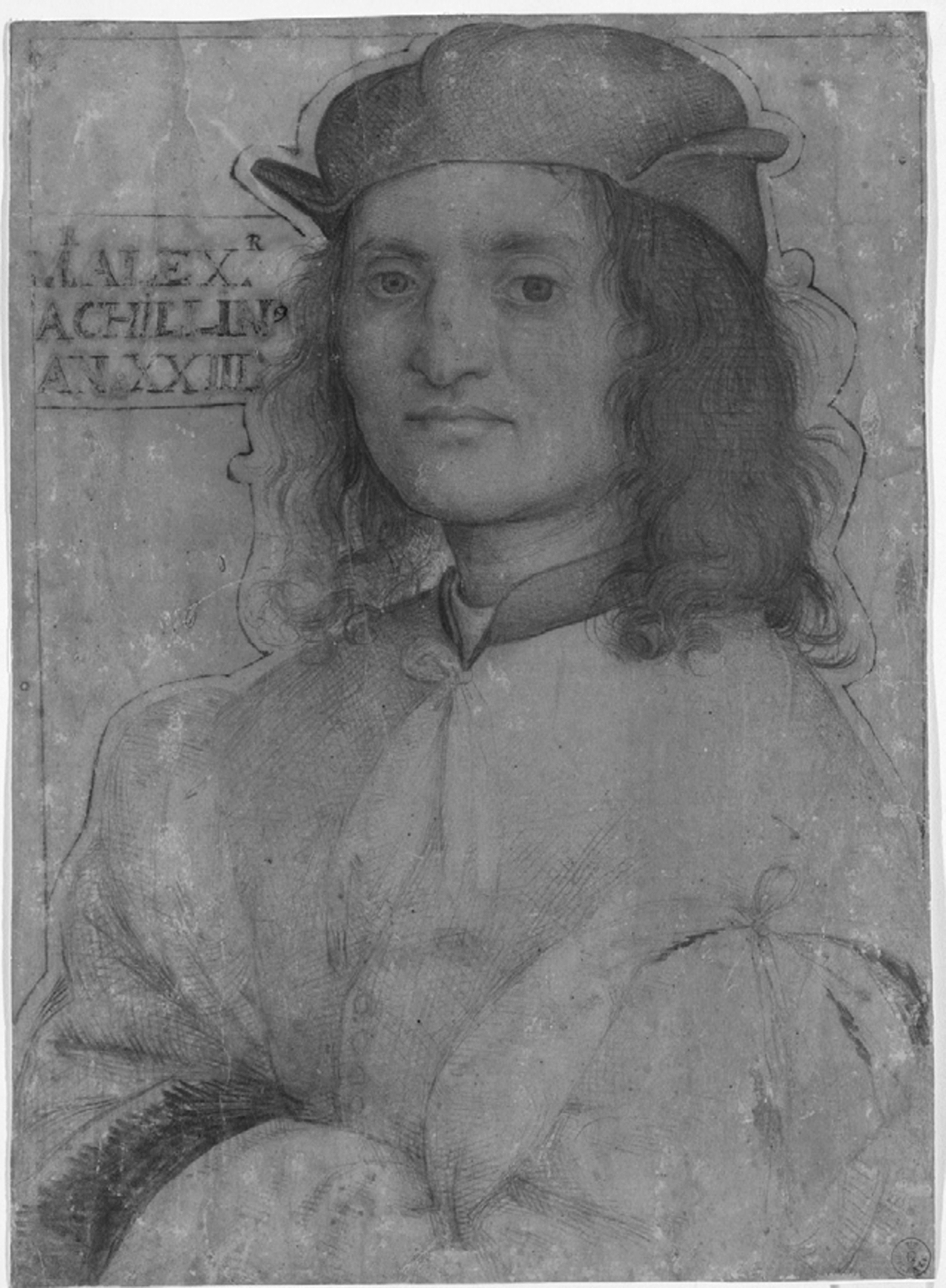
Figure 13. Amico Aspertini. Portrait of Giovanni Achillini, ca. 1508–09. Red-and-black chalk and wash with pen-and-ink over contours on paper, 393 x 286 mm. Florence, Gabinetto dei Disegni e Stampe degli Uffizi, 1445F. Scala / Ministero per i Beni e le Attività Culturali / Art Resource, NY ART477387.
In addition to displaying the academic regalia of a doctor of medicine from the University of Bologna, the male portrait in the altarpiece exhibits a youthful, ruddy complexion and the prominent Adam’s apple of a twenty-year-old recent graduate, the approximate age of Giacomo Arrivabene in 1504–05. And the sitter’s eyes remain unmarked by the crow’s feet clearly visible in the faces of the elder accompanying saints and aged bishop. The identification of the portrait as maestro Giacomo Arrivabene also justifies the figure’s heraldically junior position in the painting, which is appropriate for the bishop’s great-nephew. Giacomo’s presence in the altarpiece best fits patron Giovanni Pietro Arrivabene’s desire that his universal heir propagate a dynasty of humanist scholars and kneel in eternal prayer for the bishop’s soul.
Conclusion
The Arrivabene chapel’s decorative program commemorates Giovanni Pietro Arrivabene’s life and achievements, testifies to his faith, and condemns Cesare Borgia’s predatory actions. Since the bishop died before the decoration began, the question remains as to who deserves credit for its audacious allegorical imagery. Like most major Renaissance commissions, the Arrivabene chapel is the result of collaboration among participants in the enterprise.Footnote 86 The documents state that the patron dedicated his chapel to the bishop-saints Martin and Thomas Becket — the latter saint martyred for resisting secular appropriation of church assets. They make no direct reference to the legend of Saint Martin exorcising a demon from a cow. Whether Arrivabene, his executors, or his heirs specified the scene, the artist Timoteo Viti is ultimately responsible for translating the dying bishop’s wishes, the executors’ orders, and the heirs’ expectations into visual form.
The chapel was the first monumental artistic ensemble produced in Urbino after Duke Guidubaldo da Montefeltro’s restoration at the end of 1503. The approximately five years until the duke’s death in 1508 were the brief golden age celebrated by Baldassare Castiglione in the Book of the Courtier. While the idealized dialogues in that text portray Montefeltro court culture filtered through two decades of the author’s hindsight, the chapel’s imagery captures the immediate reaction key members of the Urbinate court had to Cesare Borgia’s disruption of the precarious balance of power in Central Italy. The recovery of the political and personal messages encoded into the chapel’s program illuminates the principled bishop’s characterization of the Borgia as possessed by the devil, a judgment shared earlier by Savonarola and several contemporaries. More importantly, the altarpiece’s fine execution and the rediscovery of the fresco design’s ingenious employment of heraldic symbol reveal an artist of skill and intellect who stretched the affective parameters of the devout style to denounce the Borgia. In this way, the accomplishment of the Arrivabene chapel substantiates Timoteo Viti’s position as the foremost artist of the Montefeltro court, independently of Raphael.















